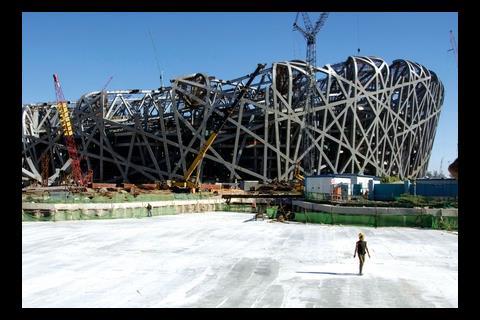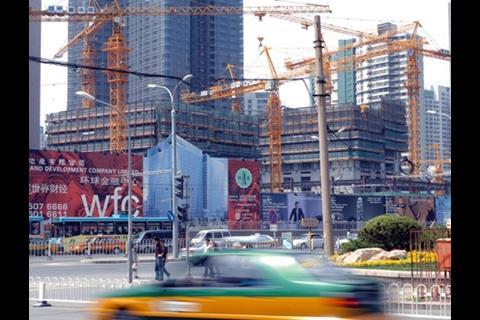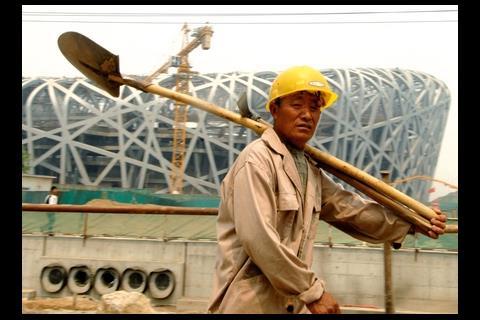As the structure of Herzog & de Meuron’s awe-inspiring ‘bird’s nest’ stadium nears completion, Catherine Wheatley went to Beijing to find out how the city’s Olympic preparations were progressing
A crane stands on what will be the finish line for athletes competing in the Beijing Olympic Games, which begin in less than 500 days.
It is one of seven giant hoists crammed into the bowl of the National Stadium, rising from a dust-choked site on the north–south axis that bisects the Chinese capital.
Raking outwards are the concrete blocks that will soon support the seating. Beyond and between the staircases, with views across to the aquatic centre and the city, are the areas that will host hospitality events. Beneath the structure, workers are excavating an underground entryway and zones for shops and snack vendors. And outside, yet more cranes are preparing the landscaping and the surrounding Olympic village.
Arching above and around the main structure is a stunning lattice of interwoven box-section steel columns, recalling the crackle glaze on a Chinese ceramic vase. This exoskeleton encloses and protects the stadium while admitting air and light. Workers clipped onto harnesses crawl over the superstructure like ants.
The stadium is a spectacular contrast to the banal office blocks and utilitarian apartments around it. Designed by Swiss architect Herzog & de Meuron, British engineer Arup Sport and their local partner China Architecture Design & Research Group, it is an iconic development intended to demonstrate China’s cultural and economic progress to the watching billions in 2008.
The project has been dubbed “the bird’s nest” by the public and such symbolism is important in China. A bird’s nest is a harmonious natural object and a dish eaten on special occasions.
“It’s clear they were looking for something architecturally dramatic. The overall excitement of the building will be amazing,” says J Parrish, architectural director of Arup Sport. “Without doubt, the Chinese will put on an amazing show.”
What form that show will take is still a bit of a mystery – at least to the arena’s architects. In the centre of the stadium a hole, at least 15m in diameter and almost as deep, is being bored. “We don’t know what it’s for,” admits Hemens Lai, one of three Herzog & de Meuron architects based in Beijing. “But we expect it’s for part of the opening ceremony.” He and the rest of the world will find out on 8 August next year.
Herzog & de Meuron isn’t the only Western architect joining the construction boom in Beijing. Across the city, work is progressing on Rem Koolhaas’ Z-shaped building for China Central Television and Paul Andreu’s egg-like National Grand Theatre.
Meanwhile China, whose rocketing carbon emissions have come under the spotlight, is consuming more than half the world’s concrete and more than a third of its steel.
Some of the stadium’s statistics are similarly awe-inspiring. The structure is 320m long, nearly 300m wide and 69m tall. It boasts unwrapped steel weighing a total of 42,500 tonnes. There will be seating for 91,000 spectators. Yet the total cost is just 3bn yuan (£198m), a quarter of the price of London’s Wembley stadium, which has a similar capacity.
There is no chance we will be late. The government has urged the main contractors to work faster
Hemens Lai, Herzog & de Meuron
As well as being the venue for a 17-day festival of sport, the brief states the stadium has to pay for itself after the Games, to enable the authorities to avoid the financial hangover that blights so many host cities.
“The big challenge is what will happen to the stadium in the future,” says Parrish. “The sky’s the limit for the events that can be put on in the public spaces, from product launches to weddings and operas.” To this end, the scheme also incorporates commercial elements including restaurants and a hotel.
Another construction headache is that the stadium stands in a seismic zone and has to be able to withstand an earthquake. “The stadium and facilities have been divided into six or eight sections and the steel exoskeleton is independent of the structure inside, so that they can all move separately,” says Parrish.
The project has not been without hiccups, however. In May 2004, a new terminal at Paris’ Charles de Gaulle airport, designed by Andreu, collapsed. As a result, the Chinese authorities halted work on the stadium while costs and safety were reviewed. Three months later, China’s president Hu Jintao ordered a financial review of all the Olympic projects, questioning whether they were too costly.
Shortly afterwards, the government asked the project team to ditch the retractable roof that was in the original brief. The roof was duly scrapped but the iconic bird’s nest, which was partly conceived to conceal the planned roof’s support structure, remained. Not only did the change make time, it also saved about 15,000 tonnes of steel and £25m.
Now, where roof cover is needed above the seats, translucent plastic membranes will be stuffed in the spaces between the steel lattice like the leaves and moss in a bird’s nest.
The structure is set to be finished in December, while the landscaping and testing is scheduled for completion in early 2008, according to Lai. “There is no chance we will be late. The government is controlling the 2008 development and they supervise carefully. A couple of months ago, they urged the main contractors to work faster,” he says.
Wembley was more than a year behind schedule when it was finished in March.
“In the UK we have to deal with the lengthy process of approvals and agreements,” says Parrish. “In China, the political system is much clearer. When the government decides to do something, it gets done.”
A lesson, perhaps, for London 2012’s organising committee as it strives to turn a grim stretch of east London into an Olympic venue. Beijing will be a tough act to follow.
The Olympian workforce
At one point, more than 7,000 construction workers were toiling at Beijing’s National Stadium, although the number has since fallen to about 1,000.
Almost all have been recruited from the countryside and sent to live on site in prefabricated huts for six-month stints. A normal shift starts at about 7am. Typically, workers earn 50 yuan (£3.30) for a 12-hour shift. More than 600 labourers chose to work through the recent Chinese new year and collect overtime and a 500 yuan (£33) bonus.
It’s a lot less than the £1,700 a week reportedly paid to Wembley steelworkers over Christmas 2005, but tens of thousands of workers on sites around Beijing consider these rates preferable to subsistence living in rural areas. Indeed, this widespread migration from the countryside has introduced a slice of the population to the comparatively high standard of living in urban areas.
As an attempt to maintain social equity, the Chinese government is investing heavily in improving conditions in the countryside. More than 100,000 rural stores were built last year, and radio and television coverage was extended to every village that has electricity and more than 50 homes, according to government figures. About 93,000km of highway linking cities and villages have been built in the past 12 months alone.
Site conditions are tough – the hours are long and in summer temperatures top 40ºC – but they are not unduly dangerous. In some industries, such as mining, the Chinese attitude towards health and safety is at best laissez-faire and Western joint venture partners have much to teach their counterparts. But at this landmark project, at least, there have been no reports of health and safety problems.
The Chinese authorities take stadium safety as seriously as Europeans, but their approach to ensuring an acceptable design is quite different. Whereas Britain construction companies comply with the government’s Green Guide and the Purple Guide that lay down design and operation guidelines, Chinese projects are monitored by professional bodies whose views are less fixed and predictable than written guidance.
Postscript
More Olympic news at www.building.co.uk/2012































No comments yet